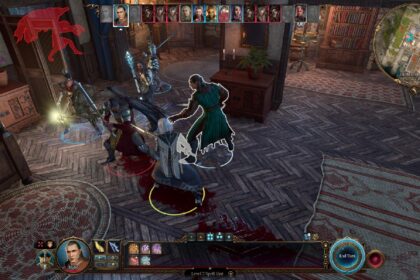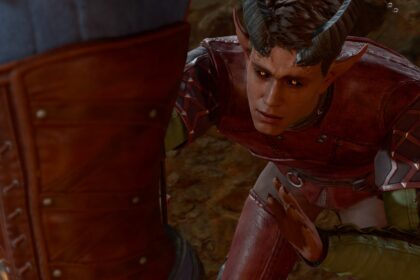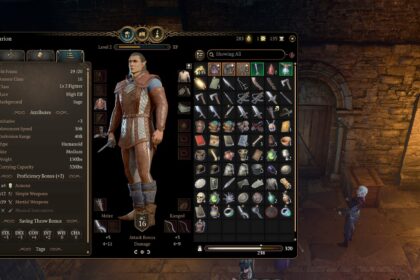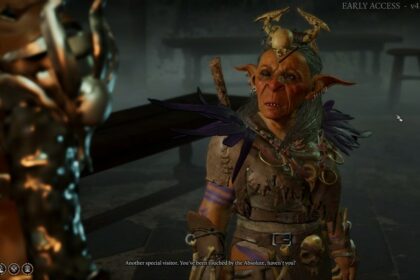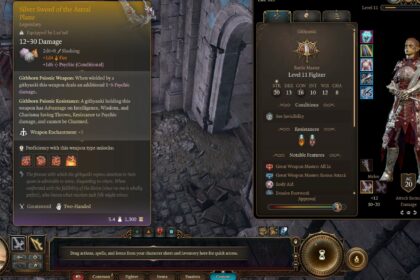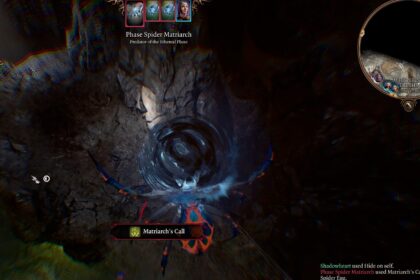Many players perceive the Warlock as a weak class in BG3, but is this true?
Despite their seemingly straightforward game plan, delving into the intricacies of playing a Warlock reveals a wealth of depth.
With our Baldur’s Gate 3 Warlock class guide, you’ll uncover the secrets to optimizing your Warlock’s spell choices, mastering effective combos, and exploring the art of multiclassing.
What is a Warlock?

Warlocks in Baldur’s Gate 3 are individuals who have entered into a mysterious pact with an all-powerful patron.
In exchange for their loyalty, Warlocks gain supernatural abilities and access to unique forms of magic.
These patrons can range from infernal beings to eldritch horrors; each bestowing distinct powers upon their chosen Warlocks.
Warlock Class Features
Let’s begin by examining the fundamental features that define the Warlock class.
Hit Points
- Hit Points at 1st Level: 8 + Constitution modifier
- Hit Points at Higher Levels: 5 + Constitution modifier
Warlocks have a decent pool of hit points; making them relatively durable, especially with a favorable Constitution modifier.
Proficiencies
- Armor: Light Armor
- Weapons: Simple Weapons
- Saving Throws: Wisdom, Charisma
- Skills: Choose any 2 Skills from – Arcana, Deception, History, Intimidation, Investigation, Nature, Religion
Warlocks are proficient in light armor and simple weapons, allowing them versatility in combat.
Their saving throw proficiencies in Wisdom and Charisma make them mentally resilient.
Additionally, they can choose from various skills, enhancing their utility outside combat.
Equipment
- Padded Armor
- Simple Boots
- Dagger
- Health Potion x2
- Scroll of Revivify
Warlocks start with a selection of equipment that ensures their survival and versatility in various situations.
Pact Magic
Warlocks have a unique approach to spellcasting known as Pact Magic. They can cast spells through their pacts, which include a selection of cantrips and spell slots.
- Cantrips: Choose 2 Cantrips
- Spell Slots: 1 Level 1 Slot
Understanding how Pact Magic works is crucial for Warlocks to harness their magical abilities effectively.
Unique Feature: Eldritch Blast
Eldritch Blast is a signature ability of Warlocks. It’s their go-to ranged magic attack that they can use at will.
It serves as their primary damage-dealing option and can be enhanced through Eldritch Invocations for increased damage and battlefield control.
Warlock Class Progression
As Warlocks level up, they gain access to various features and abilities that further define their playstyle. Here’s a breakdown of their class progression.
| Level | Class Features |
|---|---|
| 1 | Choose a Warlock Patron (The Fiend, The Great Old One, The Archfey) |
| 2 | Pick 2 Eldritch Invocations, Gain an additional Spell Slot |
| 3 | Pick 1 Pact Boon (Pact of the Chain, Pact of the Blade, or Pact of the Tome) |
| 4 | Pick a Cantrip, Choose a Feat from the Feats list |
| 5 | Deepened Pact, Pick 1 Eldritch Invocation |
| 6 | Subclass Feature |
| 7 | Pick 1 Eldritch Invocation |
| 8 | Choose a Feat from the Feats list |
| 9 | Pick 1 Eldritch Invocation |
| 10 | Pick a Cantrip, Gain a Subclass Feature |
| 11 | Mystic Arcanum – Pick 1 Level 6 Spell, Gain an additional Spell Slot |
| 12 | Pick 1 Eldritch Invocation, Choose a Feat from the Feats list |
This progression system allows Warlocks to tailor their abilities to their preferred playstyle and patron.
Warlock Subclasses
Warlocks in Baldur’s Gate 3 and Dungeons and Dragons forge pacts with otherworldly entities known as patrons to get their powers.
These patrons grant Warlocks extraordinary powers and abilities, shaping their abilities and, therefore, their playstyle.
Here, we delve into the three available Warlock subclasses, each associated with a different patron: The Fiend, The Great Old One, and the Archfey.
The Fiend

The Fiend is a subclass of Warlock that draws its power from infernal entities.
These Warlocks channel the essence of evil and corruption, serving their fiendish patrons with unwavering loyalty.
Here’s what you need to know about The Fiend Patron subclass:
- Primary Ability: Charisma
- Saving Throw Proficiencies: Wisdom & Charisma
- Hit Dice: 1d8
- Proficiencies: Simple weapons and Light Armor
Warlocks in service to fiends work toward corrupt and destructive goals, intentionally or not, and receive hellish blessings in return. Their features progression includes:
- Level 1 – Dark One’s Blessing: Whenever you reduce a hostile creature to 0 Hit Points, you gain temporary hit points equal to your Charisma Modifier + Warlock Level.
- Level 6 – Dark One’s Own Luck: Once per Short Rest, you can call on your patron to add a 1d10 to an Ability Check.
- Level 10 – Fiendish Resilience: You can choose a damage type to become resistant to, changing it after each Short Rest. You can have only one type of resistance at a time.
The Great Old One
Some Warlocks bind themselves to eldritch beings from the Far Realms known as The Great Old One Warlocks.
These enigmatic patrons grant their followers powers over entropy and the mind. Here’s the information for The Great Old One Patron subclass:
- Primary Ability: Charisma
- Saving Throw Proficiencies: Wisdom & Charisma
- Hit Dice: 1d8
- Proficiencies: Simple weapons and Light Armor
Warlocks bound to a Great Old One work toward inscrutable goals, gaining strange powers. Their features progression includes:
- Level 1 – Mortal Reminder: When you land a Critical Hit against a creature, that creature and nearby enemies are Frightened until the end of their next turn.
- Level 6 – Entropic Ward:You can impose Disadvantage on an Attack Roll against you as a reaction. If the attack misses, you gain Advantage on your next attack roll against your attacker for 1 turn.
- Level 10 – Thought Shield: Psychic Resistance: You gain Resistance to Psychic damage.
- Level 10 – Thought Shield: Psychic Reflection: When you take Psychic damage, your attacker takes the same damage.
The Archfey
Some Warlocks serve a lord or lady of the fey, mysterious beings of legend known as Archfey.
Don’t get fooled by these creatures, though. Archfeys can be as twisted and evil as the other patrons.
Archfeys offer powers associated with the Feywild and its beguiling magic. Here’s what you need to know about The Archfey Patron subclass:
- Primary Ability: Charisma
- Saving Throw Proficiencies: Wisdom & Charisma
- Hit Dice: 1d8
- Proficiencies: Simple weapons and Light Armor
Warlocks graced by a lord or lady of the fey gain qualities of their patron’s extraordinary realm. Their features progression includes:
- Level 1 – Fey Presence: Charm or Frighten nearby foes with the feywild’s beguiling, disturbing magics.
- Level 6 – Misty Escape: Upon taking damage, you become invisible. You can cast Misty Step on your next turn, breaking your invisibility.
- Level 10 – Beguiling Defenses: You become immune to being charmed, and when another creature attempts to charm you, you can use your reaction to turn the charm back on that creature.
Warlock Spellcasting

Like their D&D 5th Edition version, Baldur’s Gate 3 Warlocks cast spells differently than other spellcasting classes.
They have a limited number of spell slots but regain all expended spell slots after a short rest.
This unique feature grants them incredible versatility and ensures they remain a potent force in battle.
Warlock Spell Slots
Here’s a breakdown of Warlock spell slots and how they progress as the character levels up:
| Warlock Level | Eldritch Invocations | Cantrips Known | Spell Slots | Spell Slot Level |
|---|---|---|---|---|
| Level 1 | – | 2 | 1 | 1st |
| Level 2 | 2 | 2 | 2 | 1st |
| Level 3 | 2 | 2 | 2 | 2nd |
| Level 4 | 2 | 3 | 2 | 2nd |
| Level 5 | 3 | 3 | 2 | 3rd |
| Level 6 | 3 | 3 | 2 | 3rd |
| Level 7 | 4 | 3 | 2 | 4th |
| Level 8 | 4 | 3 | 2 | 4th |
| Level 9 | 5 | 3 | 2 | 5th |
| Level 10 | 5 | 4 | 2 | 5th |
| Level 11 | 5 | 4 | 3 | 5th |
| Level 12 | 6 | 4 | 3 | 5th |
This table outlines the progression of Warlock spell slots and their associated spell slot levels.
Pact Boons
Warlocks gain access to Pact Boons, which shape their playstyle and grant unique abilities. Let’s explore each of the Pact Boons available to Warlocks.
Pact of the Chain
Pact of the Chain allows Warlocks to form a special bond with a familiar spirit. This boon offers additional utility and versatility in both combat and exploration.
At level 5, your familiar can attack twice instead of once, enhancing its combat capabilities.
When choosing Pact of the Chain for your Warlock in Baldur’s Gate 3, here are some essential tips and notes to consider:
Familiar Choices
You have the option of two familiars: Imps and Quasits. Here’s what you need to know about them:
- Imps: Generally considered more potent than Quasits. They deal more damage, can poison enemies, and have slightly higher hit points. Additionally, Imps are immune to poison and possess resistance to all damage types.
- Quasits: While not as offensive as Imps, Quasits can fear an enemy once per Short Rest, adding a crowd control element to your arsenal. Like Imps, they also have resistance to all damage.
Remember that you can swap between Imps and Quasits after initially choosing one. This flexibility allows you to adapt your familiar to different situations and challenges.
Sneak Attack Limitations
Keep in mind that when you perform a sneak attack, the Imp can only attack once. Consider this when planning your combat tactics and coordinating with your familiar.
Tactical Use of the Imp
The Imp’s abilities make it an excellent choice for various roles:
- Luring Enemies: The Imp can lure enemies into favorable positions, setting them up for area spells or advantageous combat situations.
- Scouting: With its small size and flying ability, the Imp is a valuable scout. Use it to gather information about enemy positions and traps ahead of your party.
Pact of the Blade

Warlocks who choose Pact of the Blade gain the ability to summon and bind weapons, enhancing their combat prowess.
This boon allows Warlocks to use their Primary Spellcasting Ability Modifier for their pact weapon attacks, offering flexibility in weapon choice.
For Warlocks who choose the Pact of the Blade in Baldur’s Gate 3, here are some valuable tips and notes to consider:
Binding a Pact Weapon
Binding a pact weapon is akin to gaining proficiency with that specific weapon. This allows you to wield it effectively and make the most of its capabilities.
This is especially good when you find a powerful weapon in BG3 that your character wouldn’t otherwise be able to make use of.
Changing Your Bound Weapon
Keep in mind that you can change your bound weapon at any time. This flexibility allows you to adapt your weapon choice to different combat scenarios and challenges.
Simply unbind the previous weapon to free yourself to bind a new one.
Multiclassing Potential
The Pact of the Blade is particularly well-suited for multiclassing. Consider combining it with the Polearm Master Feat to achieve decent damage output.
This combination can enhance your character’s combat capabilities significantly.
Bonus Attack Specifics
It’s important to note that the bonus attack granted by the Pact of the Blade only applies to your main weapon.
Since Warlocks can’t cast spells without a free hand, your main weapon must be a melee weapon. Plan your equipment and combat tactics accordingly to maximize the benefits of this pact.
Pact of the Tome
Pact of the Tome empowers Warlocks with a grimoire known as ‘The Book of Shadows,’ granting access to additional cantrips and unique spells.
At level 5, Warlocks can cast Animate Dead, Call Lightning, and Haste once per long rest. This boon offers versatility and utility in various situations.
Here are some Pact of the Tome Tips & Notes:
Expanded Spellcasting at Level 5
At level 5, you gain access to an Eldritch Invocation that allows you to expand your spellcasting capabilities.
This feature gives you three additional spells: Ray of Sickness, Chromatic Orb, and Silence.
You can use these spells once per long rest, significantly enhancing your versatility in spell selection and utility.
Broaden Your Spellcasting Repertoire
Pact of the Tome is compelling for Warlocks looking to diversify their spellcasting options.
It allows you to access a broader range of spells, making your character more adaptable and better suited for various situations.
Eldritch Invocations
Warlocks gain access to Eldritch Invocations, which grant them unique abilities and enhancements.
These invocations become available at various levels, significantly impacting how Warlocks approach challenges.
Warlocks first unlock Eldritch Invocations at level 2. Subsequently, they gain access to additional invocations at levels 5, 7, 9, and 12.
Once you choose an invocation, you cannot change it as you level up, so make your selections carefully.
Here’s an overview of the available Eldritch Invocations:
| Invocation | Minimum Warlock Level | Effects and Mechanics |
|---|---|---|
| Agonizing Blast | Level 2 | Boosts Eldritch Blast damage by adding Charisma modifier. |
| Armour of Shadows | Level 2 | Cast Mage Armor at will without using a spell slot or materials. |
| Beast Speech | Level 2 | Gain the ability to communicate with beasts. |
| Beguiling Influence | Level 2 | Proficiency in Deception and Persuasion skills. |
| Devil’s Sight | Level 2 | See normally in darkness, even magical darkness. |
| Fiendish Vigor | Level 2 | Cast False Life at will without expending spell slots or materials. |
| Mask of Many Faces | Level 2 | Cast Disguise Self at will without expending spell slots or materials. |
| Repelling Blast | Level 2 | Push the target away when hitting with Eldritch Blast. |
| Thief of Five Fates | Level 2 | Cast Bane once using a Warlock spell slot. |
| One with Shadows | Level 2 | Become invisible until you move or take an action. |
| Mire the Mind | Level 5 | Cast Slow once using a Warlock spell slot. |
| Sign of Ill Omen | Level 5 | Cast Bestow Curse once using a Warlock spell slot. |
| Book of Ancient Secrets | Level 7 | Inscribe a wider range of spells into your Book of Shadows. |
| Dreadful Word | Level 7 | Cast Confusion once using a Warlock spell slot. |
| Sculptor of Flesh | Level 7 | Cast Polymorph once using a Warlock spell slot. |
| Minions of Chaos | Level 9 | Cast Conjure Elemental once using a Warlock spell slot. |
| Otherworldly Leap | Level 9 | Gain the ability to jump great distances. |
| Whispers of the Grave | Level 9 | Cast Speak with Dead at will without expending a spell slot. |
| Lifedrinker | Level 12 | Your pact weapon deals extra damage equal to your Charisma modifier. |
Warlock Tips & Builds

Playing as a Warlock might initially appear straightforward: cast a couple of spells, retreat, and rely on Eldritch Blast until the encounter concludes.
While this basic strategy is adopted by many, it, unfortunately, reinforces the Warlock’s reputation as one of the less versatile spellcasting classes in both D&D 5e and Baldur’s Gate 3.
However, delving deeper into the game’s intricacies reveals the true potential of the Warlock.
Understanding the nuances of this class can unlock a world of possibilities, enabling you to harness the Warlock’s unique abilities to their fullest extent.
Spell Choices and Combos
Optimize your spell choices and combos for maximum effectiveness:
- Hex: Use Hex to inflict extra damage, and remember to recast it after defeating an enemy to maintain sustained bonus damage without consuming additional spell slots.
- Eldritch Blast: This is your primary damage-dealing spell. Enhance it with the following invocations:
- Agonizing Blast: Increases damage.
- Repelling Blast: Provides battlefield control.
- Gemini Gloves: Equip these gloves to boost Eldritch Blast with the Adroit Caster ability, allowing your cantrips to target one more enemy or ally.
- Combine Misty Step with Eldritch Blast for repositioning and gaining Advantage in combat.
- Counterspell: Select this spell to control the battlefield and prevent enemies from casting powerful spells. Save your spell slots for Counterspell when relying heavily on Eldritch Blast for offense.
- Staff of Spellpower: Pair Counterspell with this staff for its powerful Arcane Battery ability, allowing you to cast a spell without expending a spell slot.
Spells and Feats
Consider choosing versatile spells or extremely powerful ones.
For instance, Hunger of Hadar for area denial, damage, and crowd control. Meanwhile, although Fireball is not as versatile, it has significantly higher damage than other spells of its level.
Make sure to select appropriate feats to enhance your performance during combat. For instance, the War Caster and Resilient feats are great choices for Warlocks.
These two feats help you maintain concentration on spells like Cloud of Daggers, Hunger of Hadar, Darkness, and others.
Eldritch Blast Scaling
Remember that Eldritch Blast gains additional beams at character levels 5 and 10, not Warlock levels. This opens up powerful multiclassing options for your character.
By following these tips and building your Warlock strategically, you can make the most of their unique abilities and contribute effectively to your party’s success in Baldur’s Gate 3.
Warlock Multiclassing

Sometimes, a single class might not offer the versatility and power required to thrive in this dangerous realm.
That’s where multiclassing comes into play. In case you didn’t know you wanted to multiclass and went only for Warlock levels, don’t worry. You can always respec your character.
Each multiclass build offers a distinct playstyle by combining the core Warlock abilities with those of another class.
This synergistic approach not only expands your character’s skill set but also unlocks new mechanics and gameplay strategies.
Warlocks multiclass well with specific classes that use Charisma for spellcasting, such as Paladin, Sorcerer, or Bard.
Most multiclassing occurs after level 3 or level 9, depending on the chosen class, as Warlocks are front-loaded.
Keep in mind that Warlock spell slots don’t level up when multiclassing.
If you want stronger spell slots, you must keep taking levels in Warlock. However, this is not a major problem if you are going for these builds:
Warlock/Sorcerer
You primarily rely on Eldritch Blast for ranged damage. Still, your Sorcerer levels grant you access to Metamagic, allowing you to quicken spells or twin them for increased versatility.
Your Draconic Bloodline offers additional hit points and damage resistance, making you a formidable presence on the battlefield.
You can also access a broader range of spells, enhancing your ability to control and shape the flow of combat.
Combining the Warlock’s Eldritch Blast with the Sorcerer’s Metamagic helps you maximize damage output and versatility.
Eldritch Blast remains your primary damage-dealing option, while Sorcerer spells offer crowd control and utility.
Besides, with Quickened Spell, you can both control the battlefield and deal decent damage.
- Class Combination: Warlock (The Fiend) 5 / Sorcerer (Draconic Bloodline) 7
- Primary Ability: Charisma
- Key Features:
- Eldritch Blast for consistent ranged damage.
- Quickened Spell and Twinned Spell Metamagic from Sorcerer for versatility in spellcasting.
- Draconic Bloodline adds extra hit points and damage resistance.
- Access to Sorcerer spells like Shield for defense and powerful AoE spells like Fireball.
Warlock/Paladin
You continue to use Eldritch Blast for ranged damage, but your Paladin levels provide access to Divine Smite, which adds extra damage to your melee attacks.
You can also wield Paladin spells like Divine Favor and Wrathful Smite for added utility and damage.
Your Aura of Protection grants a bonus to saving throws, enhancing your overall resilience and your role as a protector on the battlefield.
This combination of classes provides versatility in combat and utility through Paladin spells like Lay on Hands.
- Class Combination: Warlock (The Fiend) 5 / Paladin (Oath of Vengeance) 7
- Primary Ability: Charisma
- Key Features:
- Eldritch Blast for ranged damage.
- Divine Smite from Paladin for extra damage on melee attacks.
- Access to Paladin spells like Divine Favor and Wrathful Smite.
- Aura of Protection for a bonus to saving throws.
Warlock/Bard
Eldritch Blast remains your primary ranged damage source, while Bardic Inspiration empowers your allies.
Cutting Words allows you to hinder your foes, altering the outcome of critical moments.
Access to Magical Secrets allows you to select spells from any class, expanding your utility and adaptability in various situations.
A Warlock/Bard is a good support with decent damage-dealing capabilities. Thanks to your Bard levels, you can crowd control, heal, and offer out-of-the-box solutions to complex challenges.
- Class Combination: Warlock (The Archfey) 5 / Bard (College of Lore) 7
- Primary Ability: Charisma
- Key Features:
- Eldritch Blast for ranged damage.
- Bardic Inspiration for buffing allies.
- Cutting Words for debuffing enemies.
- Magical Secrets from Bard for access to a wide range of spells.

